Bitcoin Shorting Guide - Make money when Bitcoin drops

If you have spent any time trading Bitcoin and trying to make a profit on it, you know it is a highly volatile asset and that you are constantly at the risk of losing all your money.
But how can you make a profit from this volatility by shorting it?
In this guide I’m going to teach you how to short sell bitcoins (and other forms of cryptocurrency) when the price is about to drop. This step-by-step process will allow you to actually make a PROFIT in trading bitcoins.
Table of Contents :
Chapter 1 - What is Short-selling?
Chapter 2 - Why Most Profitable Traders Short-sell Bitcoin
Chapter 3 - How to Select the Perfect Time for Shorting Bitcoin
Chapter 4 - The 6 Most Profitable Bitcoin Shorting Strategies
Chapter 5 - Which Crypto Exchange Should you Choose to Start Trading?
Chapter 6 - Top Tools Used by Advanced Traders to Short Sell Bitcoin
Chapter 7 - Is Short-selling Bitcoin Risky for Beginners?
Chapter 8 - Conclusion
Chapter 1 - What is Short-selling?
Before we begin learning how to short-sell bitcoins, it’s important to understand the underlying concept of short-selling.
Let’s explain it by putting it in the context of a physical good :
Consider you ‘borrow’ a mobile phone worth $500 from your friend. But you know that the competition among mobile manufacturing companies has increased, and that the price of the mobile phone is bound to fall. So you sell the phone to another party for $500 that you put in your account.
Shortly after, as you predicted, the price of the mobile phone drops to $350.With the $500 in your account, you buy a new mobile phone at $350 and give it to your friend, keeping the extra $150 as profit!.
You just made $150 using the short-selling strategy.
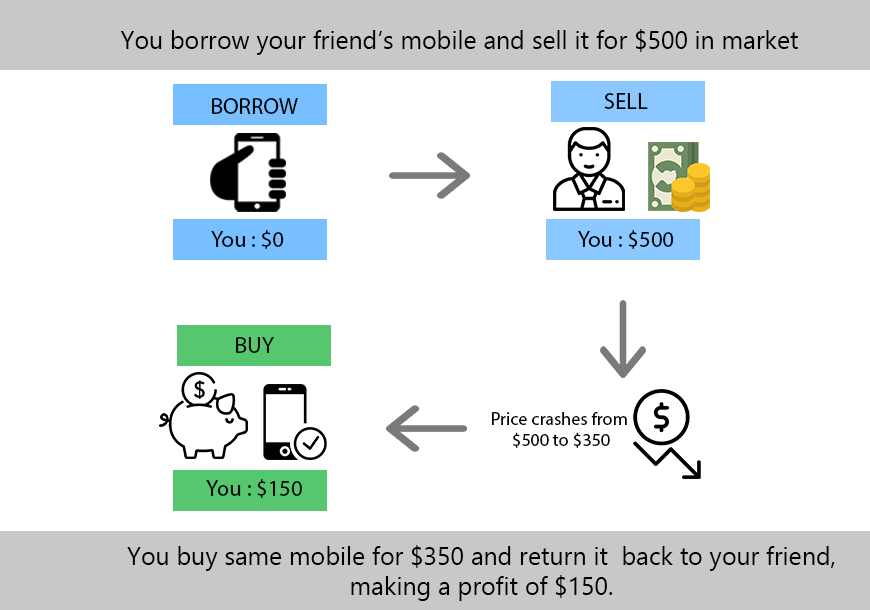
Basically, you are borrowing an asset with the obligation to return it sometime later. You sell it at the current market price. If the price of the asset declines, you buy it back and return it to the lender; a process called covering. The difference between the price at which you sold the asset and the price at which you bought it back represents your gross profit or loss.
Therefore, a short-selling technique is applied when you believe the price of the asset is bound to fall. Therefore, it is quite possible to make heavy profits on highly volatile assets like Bitcoin and make profit when bitcoin drops.
Chapter 2 - Why Most Profitable Traders Short-sell Bitcoin
As discussed in Chapter 1, the short-selling technique makes a profit when the borrowed asset’s price falls, which tends to be the case with Bitcoin because of its highly volatile nature.
Here’s proof : In 2018, the price of Bitcoin collapsed 61% - from an $8,300 high to $3,200 low in just six months.
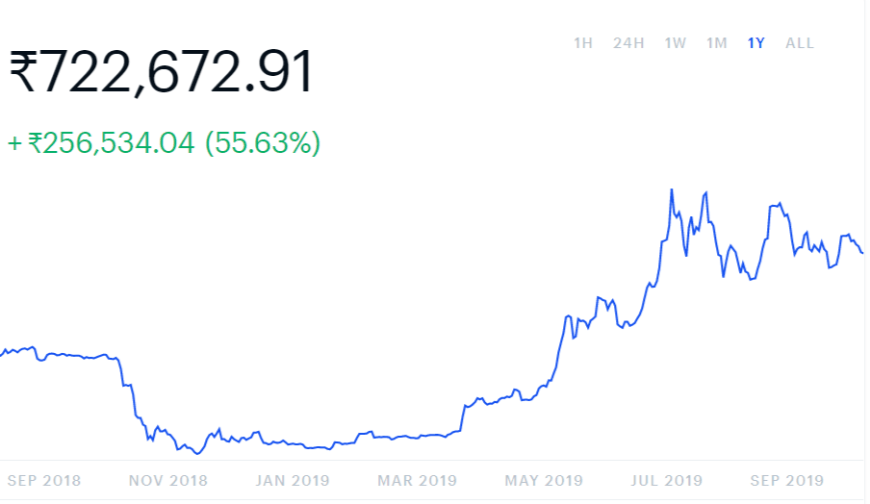
That’s a drastic fall where investors t holding short positions on Bitcoin made HUGE profits. For others, it was a disaster as they lost enormous amounts of money.
Mark Dow, a former IMF economist, was one of the traders who made hefty profits with his shorting technique. In his interview with Bloomberg, he said “The 2017 run-up in Bitcoin’s price can partly be attributed to the fact that many people didn’t understand the currency or its underlying technology, blockchain.”
In his guide to short-selling Bitcoin, he wrote that the main reasons why he shorted BTC were:
Bitcoin is volatile. Its annualized volatility is more than 100%, implying daily moves up or down of greater than 6%.
\
Exchanges are open 24/7, butBitcoin futures follow regular Globex hours.
\
The exchanges have integrity risk (such as what happened to Mt Gox) and the futures have 20% collars.
Even in 2019, the reasons mentioned by Mark Dow two years earlier still hold true. There is a high chance the history might just repeat itself; therefore you should be ready for when the price falls.
It’s not just Mark Dow lauding the short-selling process. Even Bill Gates said that he would short Bitcoin - if there was an easy way to do it. Not surprisingly his statement was criticized by Tyler Winklevoss, the ‘evangelist’ of Bitcoin.
This guide will teach you every shorting strategy step-by-step that Tyler Winklevoss mentions in his earlier post and many more new strategies that will help you predict when to short the world-famous cryptocurrency.
Chapter 3 - How to Select the Perfect Time for Shorting Bitcoin
Short-selling is profitable, but you need to be sure that the price of BTC will fall so that you can buy back the ‘borrowed’ bitcoins at a lower price.
The most interesting thing about Mark Dow’s shorting strategy was that he shorted Bitcoin at its pinnacle in 2017. In mid-December of that year, Bitcoin reached $19,783. He did a thorough analysis of BTC’s price and found a trigger to short it.
“You can see on both charts there is heavy overhead in the $15,000-$16,000 area. Going up into that area and then breaking down from it would be a logical trigger for a short. You could then set your stop and position size based on some rule that defines a violation of that pattern (e.g. two closes back up into the bounce channel).” -
Because of this analysis, he found the perfect time to short Bitcoin and made hefty profits.
To become a successful Bitcoin trader, you need to find trends that predict the price to fall or the market to become bearish.
To ascertain if the market is bearish, you need to perform two types of analysis:
- Technical Analysis: Find patterns and triggers by studying BTC price charts
- Fundamental Analysis: Understand the market and investor reactions based on certain ongoing events.
Don’t make the mistake of learning only one of the above analysis strategies as it can lead to heavy losses in the long term.
Let’s break down each of them so that you can learn to find the perfect time to short BTC.
Keep reading!
Technical Analysis
Technical analysis is all about studying the historic price chart of BTC and observing the trends. The technical analysis of any asset, not just Bitcoin, is based on the fundamentals of the Dow Theory, which include:
The market considers everything in its pricing including all existing, prior, and upcoming details that have already been integrated into current asset prices.
Market value is decided by demand and supply.
Price movements aren’t random. Rather, they often follow trends which may either be long or short term.
History tends to get repeated. Traders react the same way when presented with similar stimuli.
To implement technical analysis, you need to learn to study price charts, specifically candlestick charts
How do you read a candlestick chart?
A candlestick is composed of three parts: the upper shadow, the lower shadow, and the body. Each candlestick represents a segmented period of time.
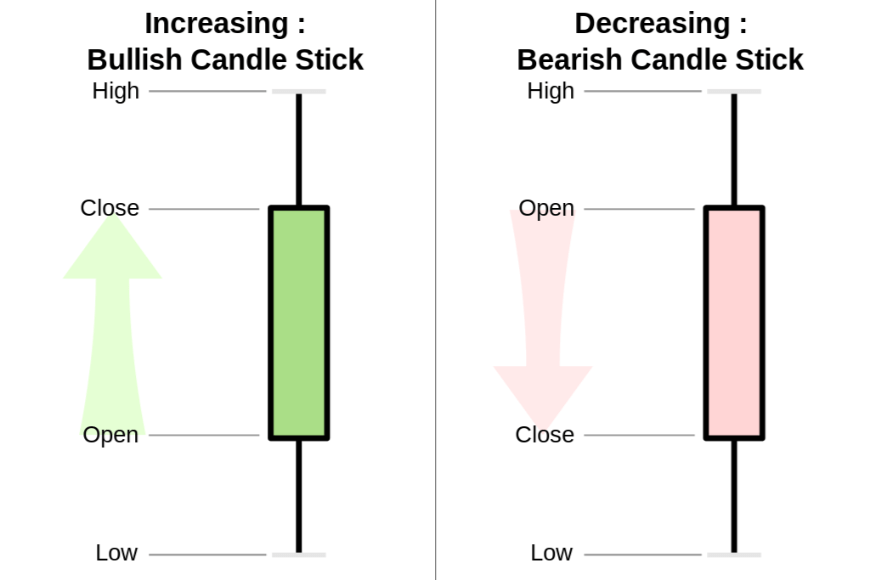
For example, a 5-minute candle represents 5 minutes of trading data. There are four data points in every candlestick:
- Open: The very first trade for the specific period.
- Close: The very last trade for the period.
- High: The highest priced trade for the period.
- Low: The lowest price trade for the period.
Source - cryptostache.com
If the close is higher than the open, then the body is colored green, representing a net price gain. If the open is higher than the close, then the body is colored red as it represents a net price decline.
Using historic price movements, expert traders have seen recurring chart patterns that can be used to predict if Bitcoin is trending bullish or bearish.
Other than patterns, traders use two other measures - Volume and Moving average - to confirm their hypothesis and be sure about the expected movement.
Based on the fundamentals, market supply and demand are important factors to observe for proper analysis. The most common measure is volume, the total number of bitcoins that were sold or bought in a given period of time. So, if 5 bitcoins were sold yesterday, that day’s total volume is 5.
Volume gives an idea about the market’s sentiment to a price change. Consider the price of BTC falling by $100. If the volume increases, especially the selling volume,with the drop in price, it suggests that the market is agreeing to the fall and this strengthens/ supports the price movement. Hence, there is a high chance that the market has gone bearish and it might be a good time to short the BTC.
You can read more about how you can use volume to find triggers if the market is headed bearish here.
Since BTC is highly volatile, the moving average can reduce the ‘noise’ or redundant price fluctuations and give you an idea about the trend direction - whether the price is increasing or decreasing.
The moving average is an average of prices in a given period. So, a 20-day MA is the average price of last 20 days of BTC prices. By using MA, you can find the direction of the trend and see if the price of BTC will fall further and justify your position of holding short on BTC. Read more about MA here.
In previous generations, traders needed to watch the price charts continuously to see the trends and volume changes. But with the advancements in technology,- you can easily set trackers on the price and get alerts via mobile or email. (We will cover this in Chapter 8. )
Volume and MA are the basics of technical analysis, but you can go further in-depth with more evolved technical analysis methods to really dig deep on the subject. Some top resources include:
Fundamental Analysis
For a stock, fundamental analysis is about studying the balance sheets of the company to conclude if it’s a good bet to put money into it.
But for Bitcoin, it’s a bit more complex to study cash flows. Hence, crypto traders do fundamental analysis a bit differently than the fundamental analysis of stocks.
The main metrics traders use to do fundamental analysis of Bitcoin are :
- User adoption
- Blockchain, its underlying technology
- Confirmed transactions per day
- Macroeconomic events
For example, in Mark Dow’s analysis of Bitcoin before it went on to crash, Mark mentioned that he knew it was a bubble because people did not understand the underlying technology.
What he essentially did was a fundamental analysis of buyers and their sentiments and understanding of Blockchain.
Though technical analysis relies on the historic price movement of BTC, a common drawback of using only technical analysis is that the movement due to an unseen events cannot be predicted. A perfect example of this is when Binance, one of the world’s leading cryptocurrency exchanges, was hacked in 2019. BTC’s price fell drastically to $5,700 immediately thereafter. On the flip side, when Facebook announced the creation of Libra, a ‘stable coin’ in June 2019, BTC’s price rose aggressively past $11,000.
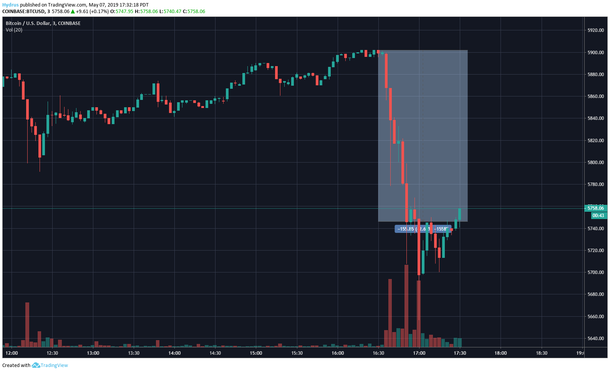
Such events cannot be predicted by technical analysis alone. You need to stay alert with events happening in the world of cryptocurrency.
To manage this risk, Bitcoin traders generally combine fundamental analysis with technical analysis. For example, a fundamental analyst might look at several indicators of demand, concluding that Bitcoin is underbought. The analyst will then leverage technical analysis by reading charts to find the best entry point.
Alternatively, a trader might use technical analysis to determine that it’s a good time to sell, and then leverage fundamental analysis to confirm this view by looking at key drivers of demand.
Chapter 4 - The 6 Most Profitable Bitcoin Shorting Strategies
Using technical and fundamental analysis, you should know if it’s time to short Bitcoin. In this chapter, we will cover the possible ways to short Bitcoin and profit.
Keep reading!
1. Direct short-selling of Bitcoin
This is the simplest type of short-selling Bitcoin. You sell off your existing Bitcoin at a price you are comfortable with. Your hope is that the value drops further; and then, if you so choose, you can buy Bitcoin again at a lower price.
This strategy might not appeal to long-term investors. However, those interested in buying and selling actual bitcoins can directly short-sell the digital coin.
Pros:
- Can be beneficial for the intra-day traders and can make use of the volatility of BTC.
Cons:
- High capital risk since you are buying Bitcoin with your own money.
- Not for long-term investors.
Places You Can Margin Trade:
2. Bitcoin futures trading
Just like other assets, Bitcoin has a futures market. You can find ways to short-sell the digital coin in the futures trade.
A future is basically a contract where the buyer agrees to buy a certain amount of Bitcoin at a future date at a specific price.
If you buy a futures contract, you’re predicting that the price of Bitcoin will rise. That way, when your contract expires, you can buy Bitcoin below the market price. However, selling a futures contract suggests a bearish outlook and a prediction that Bitcoin’s price will decline.
Pros:
- Make money in a bear market
- No commission fees
- High leverage
Cons:
- You need to be a professional trader to get the full benefits
- Mainly a speculative product
Places You Can Explore Futures:
3. Bitcoin margin trading
With this type of trading strategy, you are able to borrow money from a broker in order to make a trade, hoping that your prediction will move in your favor. It’s worthy of note that there may be a leverage factor which could either increase your profits or your losses.
Many cryptocurrency exchanges are dedicated to margin trading.
Pros:
- An increase in buying power
- Flexibility
- Exponential account growth
Cons:
- Increased risk
4. Prediction markets
In prediction markets, investors try to predict on when the next Bitcoin bubble will burst. If you think that the prediction will come to pass, you buy shares; if you think it will fail, you sell shares.
Similarly, to short Bitcoin, you’ll want to find a prediction that the price of BTC will decline and go long on it, or find one saying that the price of BTC will rally and go short on it.
Pros:
- Accuracy can be maintained using proper trading strategy tools and technical analysis.
- Long-term forecast
Cons:
- Highly speculative
- Not for novice traders
Popular Prediction Markets:
5. Binary options trading
Binary options trading involves “put” and “call” options.
Buying put options give you the right to sell a specified amount of Bitcoin which you set at a certain price at a certain time. This means that you would be aiming to be able to sell the coin at today’s price, even if Bitcoin loses value later on. Hence, the put option gains value as Bitcoin loses value. However, you are not obligated to sell the option if you don’t want to.
Meanwhile buying “call” options gives you the right to purchase a certain amount of Bitcoin at a fixed price until a certain date, which is known as the expiration date.
While binary options are available through a number of crypto exchanges, the costs, as well as risks, are quite high.
Pros:
- A small budget can still trade
- A low-cost way to trade a lot of different underlying instruments
Cons:
- Poor regulation and shady spots in history
6. Contract for Difference (CFD)
With CFD trading, the buyer and the seller of the contract agree to settle any change between the current price of a specified amount of Bitcoin and the future price in fiat currency on the date the contract expires.
For example, an investor might sell a CFD on Bitcoin for a week in the future for $1,000. If the price of BTC was $500 on the date the contract ends, the buyer would pay $500 per bitcoin specified in the contract. On the other hand, if the price of BTC went up to $2,000, they’d owe the buyer $1,000 per bitcoin specified in the contract.
CFDs helps traders diversify their portfolios by trading across different markets – and doing so with leverage, which can maximize their potential profits.
Pros:
- Trade both long and short positions
- Instant order execution
Cons:
- You can lose everything you invest
- You can easily overtrade
Which one is your go-to strategy for shorting Bitcoin?
Each of the above six profitable strategies has its own pros and cons - and to leverage the pros you can trade with a mix of the above strategies depending on the duration of your trade.
Chapter 5 - Which crypto exchange should you choose?
Image by Crypto Coin Zone
Short selling successfully requires crack timing and an exchange you can trust. Not every crypto exchange supports short selling, but the ones that do offer global services. These four stand out from the pack as the best choices for your short game.
BitMex
BitMex has been in business since 2014 and is headquartered in the Seychelles. It has traded more than 450 million BTC and does so 24 hours a day. There are no restrictions placed on its global service and it is strictly a crypto-to-crypto service. Bitcoin is among 11 cryptos that can be shorted on BitMex, which has several custom functions for the process including: FillorKill, GoodTillCancel, ImmediateOrCancel, and Reduce-Only.
You can leverage up to 100 times the coins you have in your balance. The fee structure is designed by maker/taker orders from (-0.025% to 0.25%).
Pros:
- No verification needed for short positions
- Good platform for advanced trading
Cons:
- US traders not allowed
- Only BTC has 100x leverage; other coins are 50x
Bitfinex
Bitfinex offers margin trading with short positions included. It is the largest BTC to US dollar trade around, which gives its clients a large rate of liquidity. Its leverage function can only go as high as 3.3 times the coins you have in your balance, significantly lower than BitMex. There are plenty of short functions available, including Stop, Stop-Limit, Trailing Stop, and Fill-or-Kill. Bitcoin is among the more than 40 coins that you can short.
Pros:
- Decent security
- More than 40 cryptocurrencies to trade
Cons:
- Verification required
- Leverage is only 3.3x your available coins
Markets.com
Markets has more than crypto available, but there are seven coins available to trade and short. It has solid security including SSL encryption. Conditions are not particularly favorable for optimal shorting, however. The marketplace does not operate on Fridays past 22:00 GMT and only resumes on Sunday at 23:00 GMT and leverage is not available for cryptos. On the positive side, there are no trading fees for short orders.
Pros:
- No trade fees for short positions
- Global service available
Cons:
- Must complete verification process
- Only 7 crypto coins available
EToro
EToro is unique in that it allows crypto social trading, which means traders can copy short orders from other traders. You have to verify your identity, but once that is done, you can use the service from anywhere in the world. Its leverage might be the best in the world, allowing for 400x what you have in your account.
Pros:
- High leverage and low 0.2% trading fee
- Account can be kept private
Cons:
- Verification necessary
- Not many trade functions
Chapter 6 - Top Tools Used by Advanced Traders to Short-sell Bitcoin
You don’t have to do it alone when you choose to start your own analysis for how and when to short-sell Bitcoin. The Internet is full of valuable tools that can guide you, provide you with all the data you need to make smart decisions, and give you intelligent space to track your efforts. Some of the best tools out there include:
Charts - TradingView
Website : https://www.tradingview.com/
The site focuses on technical analysis depicted in charts and is becoming known for some persistently valuable commentary. A handy crosshair tool allows you to drill down on the price of BTC at any date in the past calendar year and an intuitive dashboard can push that chart to include data down to one day or up to BTC’s all-time price range. For every commodity, TradingView offers easy-to-read graphics on its recommendations - BTC currently a solid buy - along with other relevant data that can help you make an informed decision.

News Aggregator - CoinSpectator
Website : https://coinspectator.com/
CoinSpectator is a free cryptocurrency news aggregator that enables traders, investors and enthusiasts to monitor thousands of industry news sources in real-time. It has a simple, effective color-coding system to break down the aggregate by press releases, media, blogs, and news. BTC gets its own label to make it easy to customize for just that cryptocurrency. You can sign up with just an email address and get a customized feed sent to your inbox as well.

Portfolio Management - Gem
Website : https://gem.co/
It’s a website and an app for both iOS and Android, which means convenience no matter how you like to keep up with your cryptocurrency. There are no hidden fees or special upgrades, and it can sync your balances, and follow your trades and holdings fro more than 20 crypto exchanges. It also has functionality to let you discover and research individual cryptocurrencies for future investment. You can track more than 2,000 digital assets in all.

Secret Weapon - Distill.io
Website : https://distill.io
Distill.io is the tool that you never saw coming, but once you know about it, you’ll wonder how you ever lived without it. Once installed, you can use it to click on parts of any page on the Internet that you want to track - such as the price of Bitcoin.
Distill.io then monitors that page for changes, even if it’s just in the background. The moment there’s a change in the area you selected, you’re instantaneously notified by text, email, or whatever form of communication you prefer. This includes changes in PDFs and private pages, has 24/7 monitoring via the cloud, and uses artificial intelligence (AI) to develop smart conditions for notifications, so you’re getting the exact data alerts you want while drowning out all the extraneous noise.
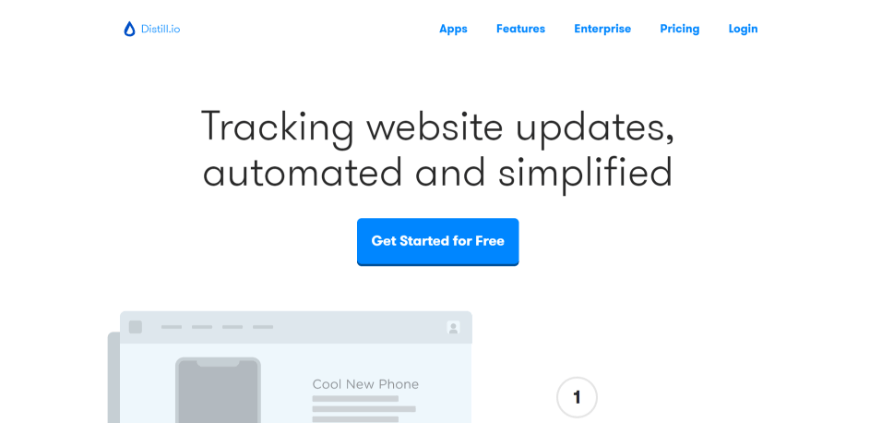
Investing in bitcoin is quite risky, more so when short-selling it because your losses could extend far beyond your initial investment.
Let’s say you short-sold $100 worth of Bitcoin back when prices were only $10 per coin. That means you short-sold 10 coins, meaning that you still have to pay the owner back with 10 bitcoins.
But if a spike suddenly drives the price up to $4,000, that means the 10 bitcoins you need to pay back will now cost you $40,000!
Only invest if you are very confident that prices will drop, and if you have money to cover your losses if investments rise. Make sure you watch prices closely and cut your losses if prices start to rise too quickly.
Chapter 8 - Conclusion
According to Steve Swain, the co-founder and CEO of LendingBlock -
“The bottom line is that I think the tools haven’t existed yet [for traders] to be able to execute all of their opinions. Shorting is an important part of putting opinions or convictions into practice.”
- Source
Because of the high volatility of cryptocurrency, going short on BTC can provide extra benefits that aren’t available using the basic “buy low, sell high” strategy. Shorting Bitcoin while going long on a different asset with a complimentary price direction, such as Ethereum, can help diversify your portfolio. There are high risks involved but if you have done enough technical analysis to be sure about it, it can help you earn profits in the cryptocurrency trading environment.
 Distill
Distill